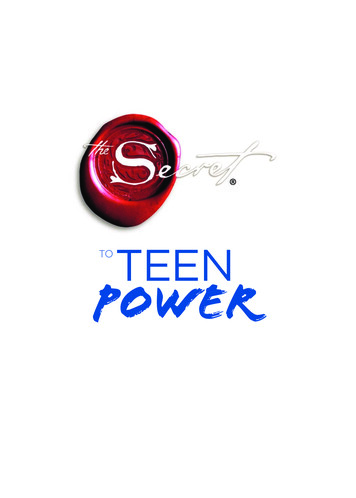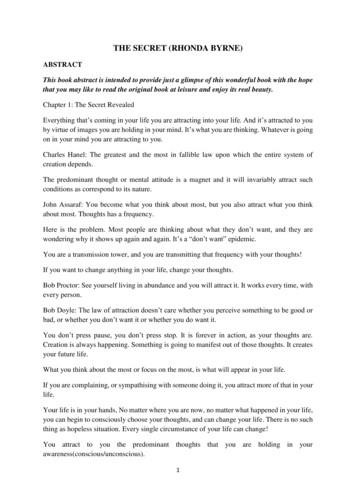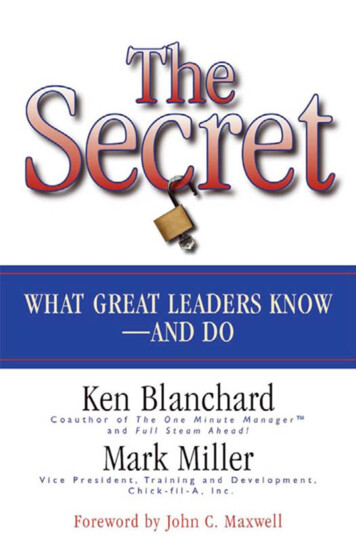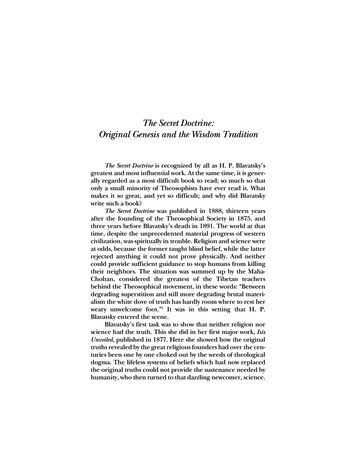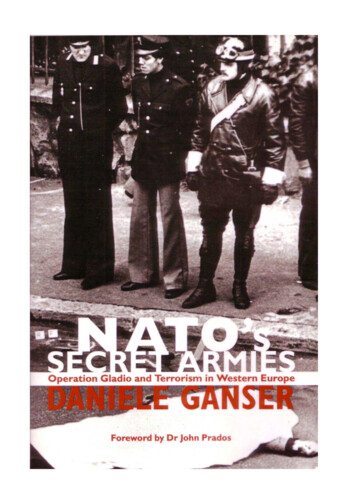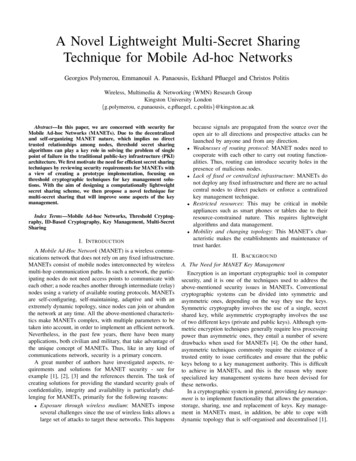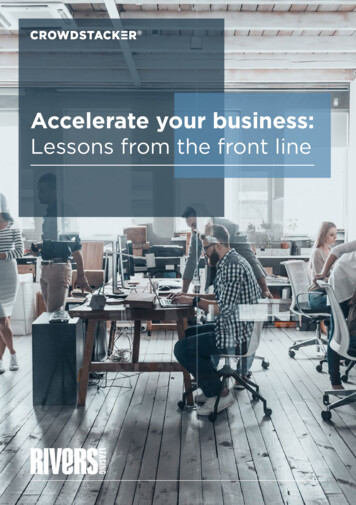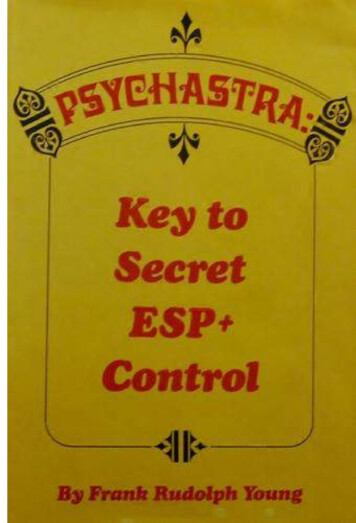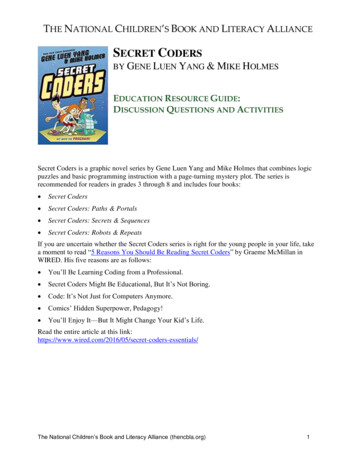
Transcription
THE NATIONAL CHILDREN’S BOOK AND LITERACY ALLIANCESECRET CODERSBY GENE LUEN YANG & MIKE HOLMESEDUCATION RESOURCE GUIDE:DISCUSSION QUESTIONS AND ACTIVITIESSecret Coders is a graphic novel series by Gene Luen Yang and Mike Holmes that combines logicpuzzles and basic programming instruction with a page-turning mystery plot. The series isrecommended for readers in grades 3 through 8 and includes four books: Secret Coders Secret Coders: Paths & Portals Secret Coders: Secrets & Sequences Secret Coders: Robots & RepeatsIf you are uncertain whether the Secret Coders series is right for the young people in your life, takea moment to read “5 Reasons You Should Be Reading Secret Coders” by Graeme McMillan inWIRED. His five reasons are as follows: You’ll Be Learning Coding from a Professional. Secret Coders Might Be Educational, But It’s Not Boring. Code: It’s Not Just for Computers Anymore. Comics’ Hidden Superpower, Pedagogy! You’ll Enjoy It—But It Might Change Your Kid’s Life.Read the entire article at this ssentials/The National Children’s Book and Literacy Alliance (thencbla.org)1
Education Resource Guide for Author and Illustrator Gene Luen YangDISCUSSION QUESTIONSPose the following questions to young people: Secret Coders opens with protagonist Hopper being dropped off at her new school, StatelyAcademy, for the first time. Hopper says she “downright dreaded transferring to StatelyAcademy.” Have you ever moved and needed to transfer to a new school? Did you dread theexperience or were you excited about it? Even if you have never needed to change schools,write a list of what might worry you and what might excite you about making such a transition.Think about other transitions you might have made in your life, such as starting on a new sportsteam or joining a new club in which all the other kids already know each other. Hopper describes her new school as looking like a “haunted house.” How does that descriptionaffect the story? Does the accompanying illustration of her school match that description? If not,how would you describe the school? Is there anything about your own school that makes youthink of a haunted house? Consider not only what your school looks like but your experiences atschool. The setting for each of the Secret Coders books is primarily Stately Academy. Can you think ofother stories in which the action takes place in a school? (Examples: Ivan the Terrible, HarryPotter series, The Magic School Bus series, Big Nate series, Princess Academy) Is a schooltypically a setting in which good or bad things happen or both? Cite examples from stories youknow. The Secret Coders books are graphic novels. A graphic novel is a story presented in the formatof a comic book. Graphic novels can include fiction and nonfiction. Make a list of how comicbooks and graphic novels are similar and how they are different. What other graphic novelshave you read? Do you prefer reading a graphic novel to a standard book with no or with limitedillustrations? Why or why not? Secret Coders includes bird robots and a robot turtle! The robot birds attack when they areshown the number 15. What other purpose do the robot birds serve? What tasks do theyperform? The robot turtle can run a program to clear the sidewalk. What other tasks can itperform? How is the robot turtle important to the story? Have you ever read a book or story that featured a robot? What types of tasks do the robots inother books or cartoons or movies perform? Do the robots in other stories perform jobs thathumans could not do because they are too dangerous? Or do they perform jobs that humansprefer not to do? If you could have a robot, what types of tasks would you want it to do for you? If you couldprogram a robot, would you want it to recognize binary numbers (like the robot birds) using its“eyes” or to execute a program when you speak the command (such as “Clear Sidewalk” or“Open Sesame”)? What other ways could you communicate with a robot to instruct it to do whatyou want?2The National Children’s Book and Literacy Alliance (thencbla.org)
Education Resource Guide for Author and Illustrator Gene Luen Yang Gene Luen Yang has said the following about the Secret Coders series, “I wanted to combineboth narrative and educational goals into a single project. I wanted the readers to connect withthe characters, and I wanted the characters to be three-dimensional—with flaws and desires thatthe readers could identify with, so that could carry them through the educational portion.” Askstudents to make a list of the primary and secondary characters in the book and to listcharacteristics for each. What flaws does each character have? What are the characters’strengths? Do students recognize any of the weaknesses and strengths in themselves? Secret Coders, the first book in the series, ends with Hopper, Eni, and Josh being required tosolve a puzzle by writing a program so they can learn the secret of Stately Academy. What doyou think about the ending? Will you try your hand at writing the Path Portal program? Are youeager to find out what happens in the next book? What do you think the secret of their school is? Gene Luen Yang wants kids to learn as much as they can about people and the world throughbooks, “Specifically, I want them to read books about people who don’t necessarily look like orlive like them. I want them to read books in a variety of different formats—prose, books inverse, and comic books—and finally, I want people to pick topics that they might findintimidating. I know a lot of kids find the inner working of computers intimidating, and Ihope Secret Coders will help them with that.” Did you know much about how computers androbots are coded before you read Secret Coders? After reading it, do you understand whatbinary means and what it means to write a computer program? If you are still unsure about whatthese concepts mean and how they work, do you feel like you understand them a little bit betterafter having read Secret Coders? Why or why not?The National Children’s Book and Literacy Alliance (thencbla.org)3
Education Resource Guide for Author and Illustrator Gene Luen YangACTIVITY: READING WITHOUT WALLSGene Luen Yang is serving as the fifth National Ambassador for Young People’s Literature, aposition appointed by the Library of Congress, Children’s Book Council, and Every Child AReader. His two-year term is 2016-2017.Each National Ambassador chooses a platform. Yang chose “Reading Without Walls.” About thisplatform, Yang states, “I want every kid—every reader, really—to explore the world through books.Books have played a vital role in getting me outside of my comfort zone. I believe they can do thesame for you.”To implement these words, Gene Luen Yang challenges all readers to read without walls in one ofthree ways:Have young people write a list of books they have read that meet one or more of the three criteria.Once they have written their lists, ask each student to share the name of his or her favorite book onthe list and explain how it meets one or more of Yang’s criteria. Ask students to write down thetitles of books that appeal to them based on their classmates’ recommendations.Take your students to the library—or encourage them to visit their local library with a familymember—to check out one or more of the books recommended. Another excellent resource is thelibrarian. Encourage students to introduce themselves to the librarian and ask for his or herrecommendations for books that meet the “Reading Without Walls” challenge.Provide students with a timeline of when they should finish their books. At that time, ask eachstudent to write or present an oral report summarizing the book and explaining if and how the book“took them out of the comfort zones.”4The National Children’s Book and Literacy Alliance (thencbla.org)
Education Resource Guide for Author and Illustrator Gene Luen YangACTIVITY: CARTOONINGA cartoon is an illustration drawn in a non-realistic or semi-realistic artistic style. Cartoons areoften simple drawings that show the features of their subjects—such as people or animals—in ahumorously exaggerated way. Cartooning as a drawing style is often used in creating comic stripsand graphic novels. Anyone can try their hand at drawing a cartoon using pens, pencils, markers, oreven a graphic design program.What’s the Difference? A cartoon is a single panel image usually used to convey an idea. Cartoons are published innewspapers, magazines, and websites. A comic book is “a book of cartoons collected in strips or panels and telling unified storiesabout characters or groups of characters. Originally designed as humorous, comic books becameincreasingly serious after 1935, eventually reaching the stage of the graphic novel.” A comicbook is a periodical, often published monthly. A graphic novel “is a story, most often Fantasy or Science Fiction, presented in the format of acomic book. After 1975 graphic novels became increasingly serious and subtle, and some wereas well-produced as standard books and magazines.” Graphic novels are published and read asbooks.Discussion QuestionsPose the following questions to young people: Read the definitions of cartoon, comic book, and graphic novel. Ask students to list examples ofeach. Compare the lists with the class. Do some works seem to fit into more than one category?If so, why? Ask young people to look closely at the cartoon illustrations in Secret Coders:o Look at the illustrations of Hopper, Eni, and Josh. Are these realistic drawings or not? Areany of their features exaggerated? Which features? Are any facial features amplified morewhen the characters are laughing or screaming? How does that inform the story?o Some of the cartoon panels include illustrations with no words. Ask students to findexamples. How does the illustration show what is happening without words?o How do the robot birds look like real birds or not?o In what ways does the robot turtle look like a real turtle? Even though it is a robot, wouldyou have easily recognized it as being modeled after a turtle? What features look morehuman than turtle-like?The National Children’s Book and Literacy Alliance (thencbla.org)5
Education Resource Guide for Author and Illustrator Gene Luen YangCreate a Cartoon Animal and Feature It in a Comic StripFollow these steps to encourage young people to develop their own concept for a cartoon animal and thenfeature it in a comic strip.1. Ask young people to think about an animal they would like to draw as a cartoon. The animalcould be a pet at home, a wild animal that lives in their yard or neighborhood, or a wild animalthat lives in a completely different habitat on another continent.2. Whichever animal they choose, ask them to start by drawing a simple sketch—this could be arealistic portrayal or not. Guide your students to choose their own method for drawing theanimal. For example, if they want to draw a mouse, ask them to draw the mouse so that it doesnot look like Mickey Mouse.3. Ask young people to collect animal photographs from old magazines and create a large photoreference scrap book as a drawing resource. Include as many photographs of animals in actionas they can. They can start making drawings based on the photographs. At first, encourage themto make quick sketches using loose circles and ovals to delineate heads, appendages, and bodyparts. They should not worry about details or if these first sketches look anything at all like theanimals.4. Students also need to watch their selected animal in motion—at home, in the backyard, at thelocal park, at the zoo, or on TV or YouTube videos. Encourage them to take a sketchbook or asmall pad of paper so they can sketch the animal in different poses, thinking about what featuresthey might like to highlight in their finished cartoon.5. Ask students to write a list of characteristics that describe their animal and its behavior. Is theiranimal happy, active, sleepy, loud, awkward, athletic? Does their animal talk? Does it conveythoughts and emotions through facial expressions and/or actions? If their animal is a four-leggedcreature, will it walk on two legs or all four?6. Having watched the animal in motion and studied photographs, ask students to begin sketchingtheir cartoon version of the animal. Are there features of the animal they might want toexaggerate? Consider enlarging the animal’s eyes or ears or tail—or some other feature.Encourage students to draw several versions and choose the one they like best to become theirfinal cartoon concept.7. Once students have finalized their cartoon concept of their chosen animal, ask them toexperiment with drawing the cartoon animal in action—sleeping, running, screaming,jumping—whatever actions are appropriate. The action sequences do not have to be limited tothe animal’s natural habitat because this is a cartoon. Encourage your students to let theirimaginations soar—their cartoon moose may find its way to the city, their cartoon kangaroomight have jumped onto the back of a plane and landed in Florida, or their cartoon penguin maysimply enjoy its adventures in Antarctica.8. Using the action sequences as inspiration, ask the students to create a complete story of comicstrips or panels featuring their cartoon animal. Young people may decide how many pages tocreate, but remember every story has a beginning, middle, and end. Student can choose toinclude dialog or captions or to let their cartoon illustrations tell the story! You may want touse the “Make a Comic” instructions as a resource.9. If possible, copy each student’s comic strip and publish as a book. Or, consider posting comicstrips on the bulletin board or scanning and publishing on a class website.6The National Children’s Book and Literacy Alliance (thencbla.org)
Education Resource Guide for Author and Illustrator Gene Luen YangLesson PlansYou may want to expand upon the Cartooning exercise, or create and customize your own, usinginformation from the following sources: “Make a Comic” by the Center for Cartoon Studies and Scholastic Art Magazine providesstep-by-step instructions that include illustrations to help explain the process.http://art.scholastic.com/resource/uploads art/Issues/1111/ART-1111-pp14-15.pdf “Creating Comics and Cartoons” on ating-comicscartoons-30291.html “Comics and Graphic Novels” on ReadWriteThink.org for Grades ls-30296.html “Comic Book Show and Tell” on ReadWriteThink.org for Grades ll-a-30312.html “Comic Creator” software tool on ReadWriteThink.org invites children and teens to design theirown comic strips. Their creations can be just for fun or as part of more structural learningactivities: planning writing activities, before- and after-reading activities, and responding tobooks. esources/games-tools/comic-creatora-30237.html “Learn to Draw a Cartoon Character” on earn-to-Draw-a-Cartoon-Character/Sources A Handbook to Literature by William Harmon and Hugh Holman. Pearson/Prentice Hall: NewJersey, 2006.“Talk Art! James Ransome’s Illustration for Episode Six of The Exquisite Corpse Adventure” byMary Brigid Barret. http://www.thencbla.org/Exquisite Corpse/exquisite ctionaries.com/definition/cartoonThe National Children’s Book and Literacy Alliance (thencbla.org)7
Education Resource Guide for Author and Illustrator Gene Luen YangACTIVITY: GET WITH THE PROGRAM!You can expand the educational potential of the Secret Coders books using the complementary andkid-friendly website Secret-Coders.com, which includes more information about the creators andthe books’ characters, an art gallery, “Fun with Coding” activities, as well as video instructions thatteach young people how to code.For students who are interested in trying to understand binary code and computer programming, besure to check out the videos on the LEARN TO CODE page.On the ACTIVITIES page, you can download and print the binary numbers game (as played byHopper and Eni in the book and shown below), as well as a coding puzzle.8The National Children’s Book and Literacy Alliance (thencbla.org)
Education Resource Guide for Author and Illustrator Gene Luen YangThe National Children’s Book and Literacy Alliance (thencbla.org)9
Education Resource Guide for Author and Illustrator Gene Luen Yang1.ONLINE EDUCATIONAL RESOURCESThe following online resources provide information related to graphic novels and comics:Comics in Education by Gene Luen YangCreated by high school teacher, cartoonist, and National Ambassador for Young People’s LiteratureGene Luen Yang, the HumbleComics.com website presents a history of how comics can be used inthe classroom, the positive outcomes, and an extensive bibliography. According to Yang, “Theeducational potential of comics has yet to be fully realized. While other media such as film, theater,and music have found their place within the American educational establishment, comics has not.”Articles and Interviews by Brigid AlversonBrigid Alverson writes about comics and graphic novels for School Library Journal. She is theeditor of the Good Comics for Kids blog and has been reading comics since she was four. She hasan MFA in printmaking and has worked as a book editor and a newspaper reporter; now she isassistant to the mayor of Melrose, Massachusetts. In addition to editing GC4K, she writes aboutcomics and graphic novels at MangaBlog, SLJTeen, Publishers Weekly Comics World, ComicBook Resources, MTV Geek, and Good E-Reader.com. “Teaching With Graphic e-graphic-advantage-teaching-with-graphic-novels/ “Good Comics for /16/brigid-alverson-on-good-comics-for-kids/ “Just Another Day in an LGBTQ another-day-in-an-lgbtq-comic/ “The People’s Comics: Using the Graphic Format to Teach About Current about-current-events/ “Teaching with Science hing-with-science-comics/ “A nonfiction roundup of Graphic ction-graphic-novels-give-these-to-fans-of-march/ “The immigrant experience in graphic hic-novels-portray-bicultural-america/ “Graphic novels that tie in with video e-changers-books-based-on-video-games/ Brigid Alverson Talk on “Graphic Novels for en/ “Interview: Eric Kallenborn on Graphic Novels in the vels-in-the-classroom/10The National Children’s Book and Literacy Alliance (thencbla.org)
Education Resource Guide for Author and Illustrator Gene Luen YangGRAPHIC NOVEL BOOKLISTSThe following online booklists from authoritative sources recommend graphic novels for differentage levels: “Graphic Novels: Read the /graphic-novels-read-pictures“Graphic Novels for Kids: Classroom Ideas, Booklists, and ��19 Graphic Novels That Engage Students and Keep Them p-them-reading“Graphic Novels: Selected Titles for Children and ilListBooks.asp?idBookLists 192“Graphic aphic-novels#“The Best Comics for Your Classroom: A List for All Grade hic Novels Reading Lists: 2016 urces/book-lists/graphicnovels2016“Great Graphic Novels for Middle -graphic-novels-middle-school/“Powerful Graphic Novels for Middle -graphic-novels-middle-school“Top 10 Graphic Novels top-10-graphic-novels-2015/“Top 10 Graphic Novels top-10-graphic-novels-2016/“Comic Relief: Thirty-Nine Graphic Novels that Kids Can’t at-kids-cant-resist/“Graphic Novels for (Really) Young The National Children’s Book and Literacy Alliance (thencbla.org)11
Education Resource Guide for Author and Illustrator Gene Luen YangARTICLES: USING GRAPHIC NOVELS IN THE CLASSROOMThe following online articles provide information about using comics and graphic novels in theclassrooms: 12“Graphic Novels for Young Kids” by Reading ic-novels-young-kids“Graphic Novel Conversation with ESL Teacher Colleen life/graphic-novel-conversion“Using Comics and Graphic Novels in the Classroom” by �Eek! Comics in the Classroom” by Linda Starrhttp://www.educationworld.com/a curr/profdev/profdev105.shtml“Comic Book Science in the Classroom” NPR Broadcast with Sarah ?storyId 4581832“'Hamlet' too hard? Try a comic book” by Teresa egn.html“Graphic Novels in the Classroom: A Teacher ng-graphic-novels/“Graphic Novels: The Bridge Between Visual and Print Media” by Stan ween-visual-and-print-mediaThe National Children’s Book and Literacy Alliance (thencbla.org)
Education Resource Guide for Author and Illustrator Gene Luen YangONLINE RESOURCES FOR COMIC STRIPSThe following online websites and articles provide lesson plans for creating comic strips.Websites Comics in the Classroomhttp://comicsintheclassroom.net/Teaching Comicshttp://www.teachingcomics.org/Articles and Lesson Plans “Comic Strip Creations Lesson plans/teaching-content/comic-strip-creations/ “Comic html?tab 4 “Comics in the Classroom as an Introduction to Genre genre-188.html “Comics in the Classroom as an Introduction to Narrative ion-narrative-223.html “Book Report Alternative: Comic Strips and Cartoon ic195.html “Using Cartoons and Comic /using-cartoons-comic-strips “Creating Comic ors/lessons/grade-3-4/creating comic strips.aspx “The Secret in the Cellar: A Written in Bone Forensic Mystery from Colonial /comic/index.html “Creative Writing Using Comics Lesson p0013 2017 by Geri Zabela Eddins and Mary Brigid Barrett; The National Children’s Book and LiteracyAllianceThe National Children’s Book and Literacy Alliance (thencbla.org)13
Secret Coders is a graphic novel series by Gene Luen Yang and Mike Holmes that combines logic puzzles and basic programming instruction with a page-turning mystery plot. The series is recommended for readers in grades 3 through 8 and includes four books: Secret Coders Secret Coders: Paths & Portals Secret Coders: Secrets & Sequences
